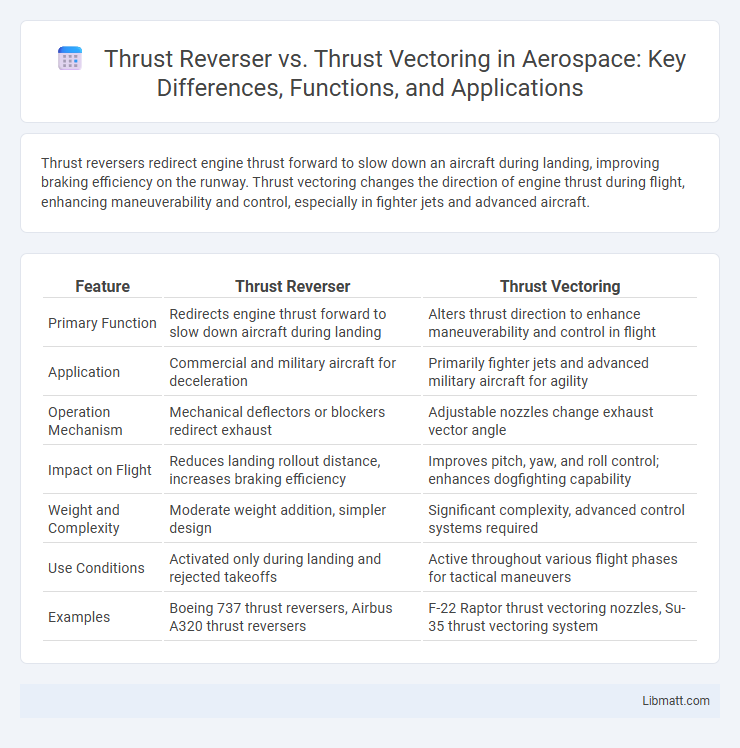Thrust reversers redirect engine thrust forward to slow down an aircraft during landing, improving braking efficiency on the runway. Thrust vectoring changes the direction of engine thrust during flight, enhancing maneuverability and control, especially in fighter jets and advanced aircraft.
Table of Comparison
| Feature | Thrust Reverser | Thrust Vectoring |
|---|---|---|
| Primary Function | Redirects engine thrust forward to slow down aircraft during landing | Alters thrust direction to enhance maneuverability and control in flight |
| Application | Commercial and military aircraft for deceleration | Primarily fighter jets and advanced military aircraft for agility |
| Operation Mechanism | Mechanical deflectors or blockers redirect exhaust | Adjustable nozzles change exhaust vector angle |
| Impact on Flight | Reduces landing rollout distance, increases braking efficiency | Improves pitch, yaw, and roll control; enhances dogfighting capability |
| Weight and Complexity | Moderate weight addition, simpler design | Significant complexity, advanced control systems required |
| Use Conditions | Activated only during landing and rejected takeoffs | Active throughout various flight phases for tactical maneuvers |
| Examples | Boeing 737 thrust reversers, Airbus A320 thrust reversers | F-22 Raptor thrust vectoring nozzles, Su-35 thrust vectoring system |
Introduction to Thrust Reverser and Thrust Vectoring
Thrust reversers redirect engine thrust forward to slow an aircraft during landing, enhancing braking efficiency and reducing runway length needed. Thrust vectoring adjusts the direction of engine exhaust to improve maneuverability and control, especially in advanced fighter jets and VTOL aircraft. Understanding these systems helps optimize your aircraft's performance and safety during various flight phases.
Fundamental Principles of Thrust Reversers
Thrust reversers operate by redirecting the engine's exhaust flow forward to create a braking force that slows the aircraft during landing. They function primarily through mechanical components such as blocker doors or cascades that alter the direction of thrust without changing the engine's power output. Understanding these fundamental principles helps optimize your aircraft's deceleration performance, especially on shorter runways or in adverse weather conditions.
Core Concepts of Thrust Vectoring
Thrust vectoring involves the redirection of engine thrust to control an aircraft's attitude or trajectory, enhancing maneuverability beyond conventional aerodynamic surfaces. Unlike thrust reversers, which primarily decelerate an aircraft during landing by redirecting exhaust forward, thrust vectoring adjusts the direction of the thrust during flight to increase agility, stability, and control at various speeds and angles of attack. Core concepts include mechanical deflection of jet nozzles, the use of movable vanes or paddles within the exhaust stream, and integration with flight control systems to modulate pitch, yaw, and roll.
Key Applications in Aviation and Aerospace
Thrust reversers primarily enhance aircraft braking performance by redirecting engine thrust forward during landing, making them essential for commercial airliners and military transport planes to reduce runway length requirements. Thrust vectoring technology, which alters the direction of engine thrust, is critical in advanced fighter jets and space launch vehicles, enabling superior maneuverability, enhanced vertical takeoff and landing capabilities, and precise trajectory control. Both systems optimize flight performance but serve distinct purposes: thrust reversers focus on deceleration and safety during landing, while thrust vectoring emphasizes agility and control during flight and ascent.
Differences in Mechanism and Operation
Thrust reversers redirect engine thrust forward to decelerate aircraft during landing by deploying clamshell doors or translating sleeves, altering airflow direction for braking. Thrust vectoring modifies the engine's exhaust direction dynamically to enhance maneuverability and control in flight by redirecting thrust via movable nozzles or vanes. The key operational difference lies in thrust reversers being used primarily for deceleration on the ground, while thrust vectoring is employed in-flight for advanced aerodynamic control.
Impact on Aircraft Performance
Thrust reversers primarily enhance aircraft deceleration by redirecting engine thrust forward, significantly reducing landing rollout distance and improving safety on shorter runways. Thrust vectoring modifies the direction of engine thrust to improve maneuverability and control at various flight conditions, enabling enhanced pitch, yaw, and roll capabilities without relying solely on aerodynamic surfaces. While thrust reversers optimize deceleration performance during landing, thrust vectoring boosts overall aircraft agility and responsiveness in flight, directly impacting combat effectiveness and operational versatility.
Advantages and Limitations of Thrust Reversers
Thrust reversers provide significant braking force during aircraft landing by redirecting engine thrust forward, enhancing safety and reducing wear on wheel brakes and tires. Their limitations include added weight, increased mechanical complexity, and potential failure risks that require rigorous maintenance. You benefit from improved stopping performance, especially on shorter runways, but must consider operational constraints in adverse weather or engine configurations.
Benefits and Challenges of Thrust Vectoring
Thrust vectoring enhances aircraft maneuverability by directing engine thrust to control pitch, yaw, and roll, enabling superior agility in both military jets and advanced UAVs. This technology offers improved performance during takeoff, landing, and combat situations but introduces complexity in design, increased weight, and higher maintenance demands. Challenges include the integration of robust control systems and ensuring reliability under extreme flight conditions while balancing cost and operational efficiency.
Technological Innovations and Recent Developments
Thrust reversers and thrust vectoring systems have seen significant technological innovations, with thrust reversers improving runway safety through advanced deployment mechanisms and noise reduction features. Recent developments in thrust vectoring technology focus on enhancing aircraft maneuverability and fuel efficiency by integrating adaptive nozzle designs and real-time control algorithms. Your understanding of these systems can benefit from recognizing how modern materials and digital automation have revolutionized their performance in both commercial and military aviation.
Future Trends in Propulsion Control Systems
Thrust vectoring technology is advancing with adaptive control algorithms and lightweight materials, enabling enhanced maneuverability and fuel efficiency in next-generation aircraft. Thrust reverser systems are increasingly integrated with real-time diagnostic tools and intelligent actuators to improve safety and reduce landing distances. Emerging propulsion control systems prioritize seamless integration of thrust vectoring and reverser functions to optimize overall aircraft performance and operational flexibility.
Thrust reverser vs Thrust vectoring Infographic

 libmatt.com
libmatt.com